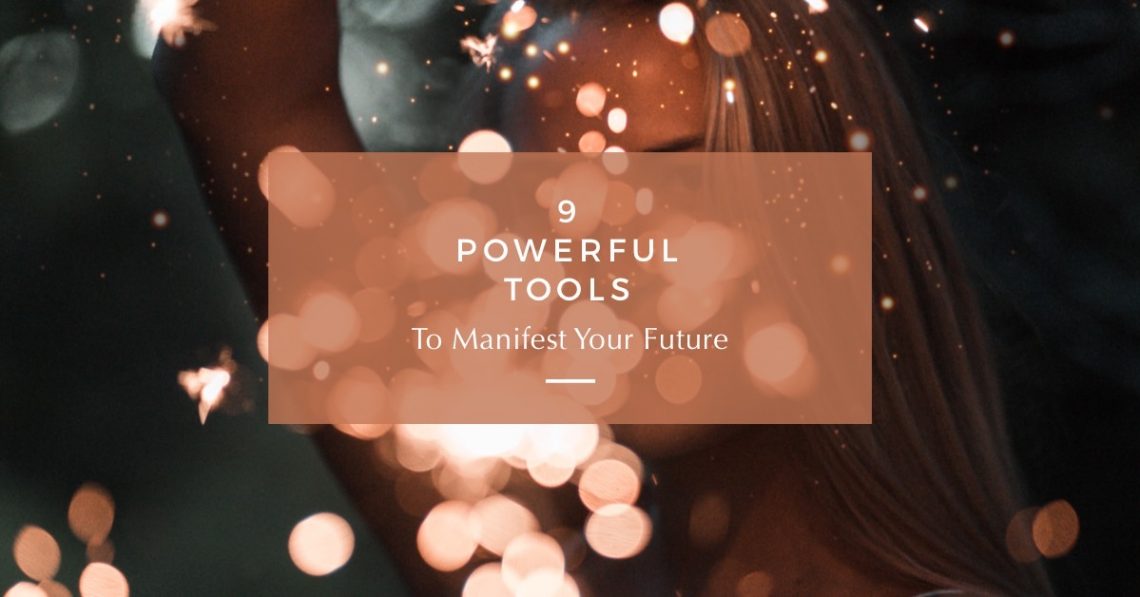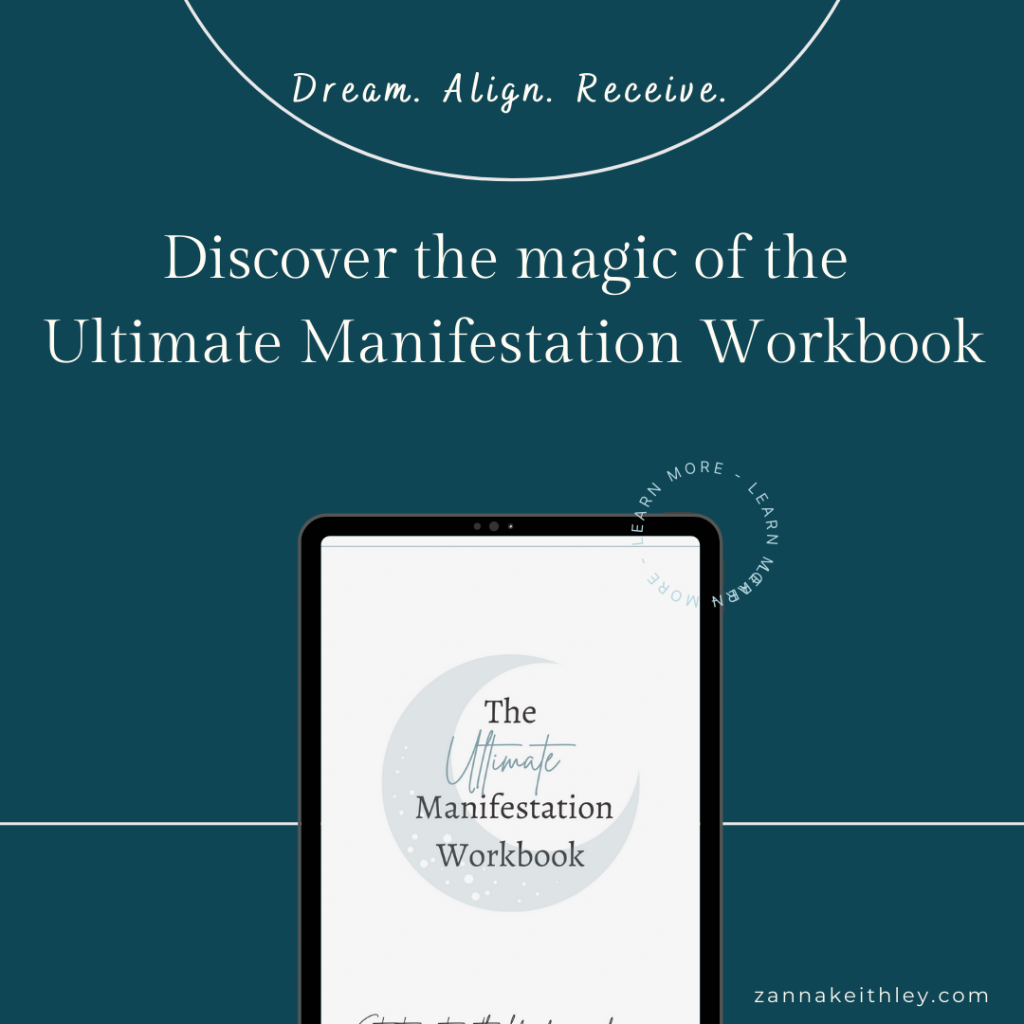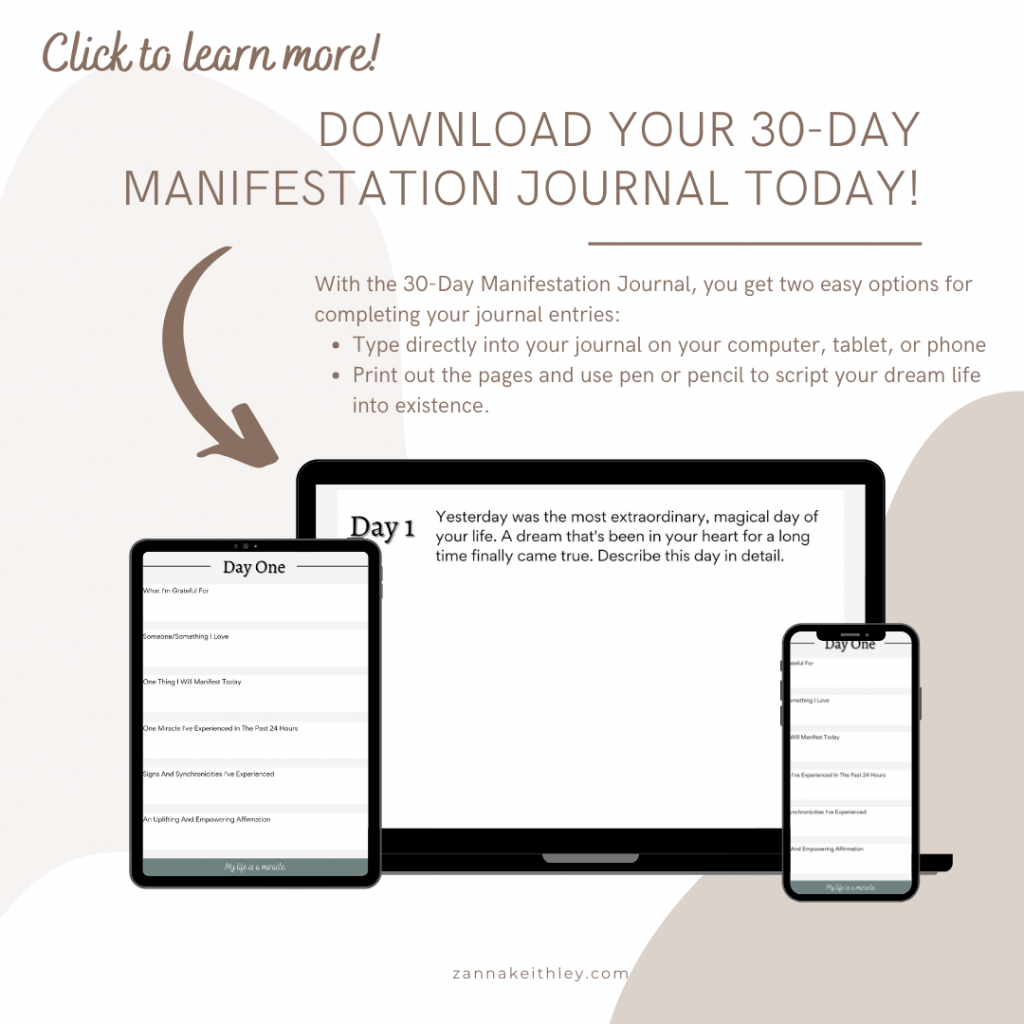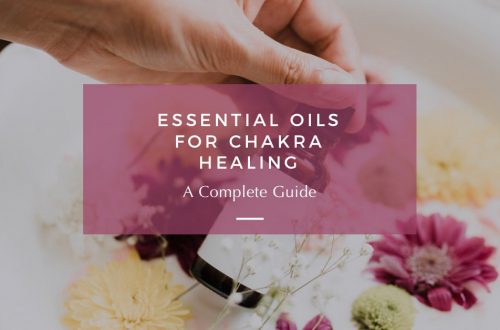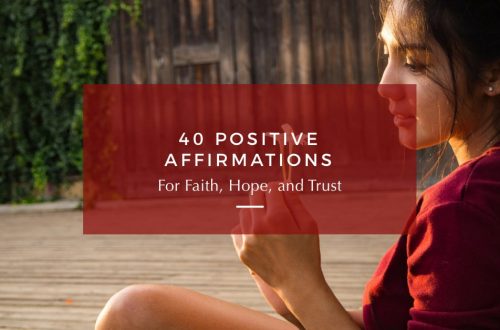-
9 Powerful Tools for Manifesting Your Future
You have everything you need within you to create a beautiful and fulfilling life—here’s nine manifesting tools for creating the life you love.
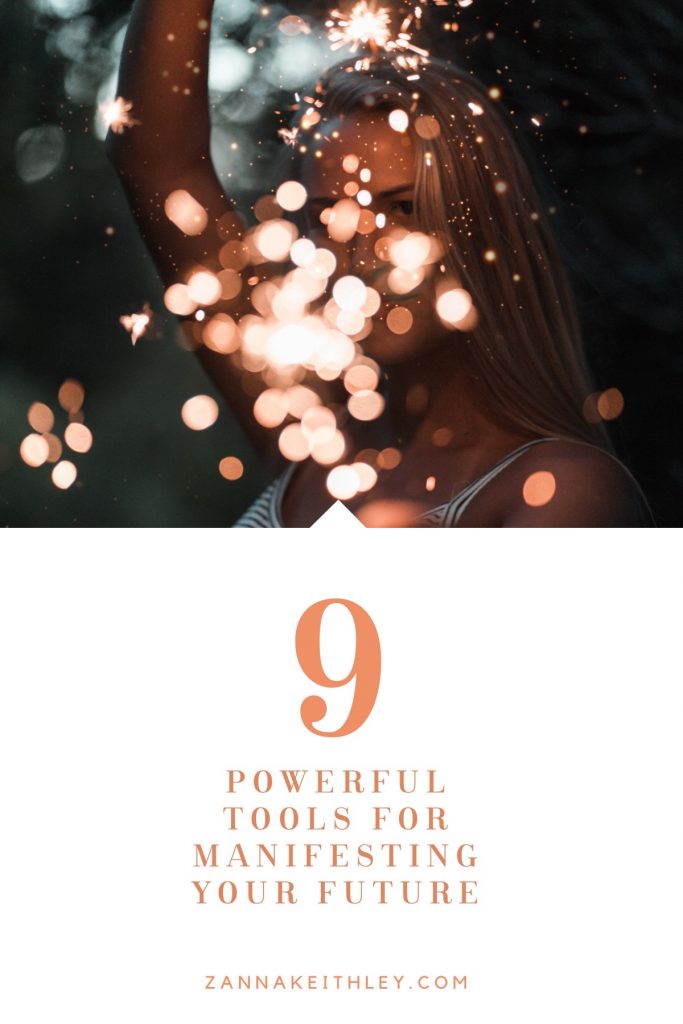
Pin this for later! 9 Powerful Tools for Manifesting Your Future What is Manifestation?
Manifestation is, by its simplest definition, creation.
You have the ability to create your life through your thoughts, actions, and feelings. You create through your deepest held beliefs. You create through the perspective you bring to every experience and situation.
When you consciously tap into your innermost power to create, you realize that the power to create a life that aligns with your deepest purpose and feels beautiful and fulfilling—the life you envision for yourself when you close your eyes—exists within you.
To expand on the definition a bit, to manifest something means to visualize your dreams and desires and to vibrate at the frequency of your desires as if they’ve already come true.
Essentially, this means that you align your thoughts, beliefs, and feelings with the thoughts, beliefs, and feelings of your highest self—the innermost you. The you who feels infinitely and unconditionally loved, abundant, beautiful, free, and at peace.
Manifestation is intertwined with the Law of Attraction, which states that like attracts like; the vibrations, beliefs, and emotions we put out into the world are what we receive in our lived experiences.
So how does this work? Below, you’ll find the nine essential tools you need to get started.
These tools as well as these manifestation games are a good place to start when you’re starting your manifestation journey. And you can get the full manifestation blueprint in my in-depth guide on how to manifest something.
Tools to Manifest Your Future
Tool #1: Visualization
To create the life you desire, you first have to know what you want.
If there were no limits or constrictions, what would you be doing in your dream life? Where would you live? Who would be surrounding you? What primary emotions would you feel? What does your highest and most authentic self look like? How does this version of yourself move throughout their day?
Visualization is a tool you can use to connect your present-day self with the version of you who is living the life you imagine for yourself when you close your eyes.
My favorite way to describe it is intentional daydreaming.
When you visualize, you directly connect your present-day self with the you who is already living the life of your dreams. It’s not just about seeing your dream life—when you visualize, you use all of your senses to simulate the experience of living your dream life in the present moment.
One of the best examples of how powerful visualization can be is how Olympic swimmer Michael Phelps incorporated it into his training routine to become the most decorated Olympian of all time.
It’s no secret that Phelps put in many long hours of practice, sometimes without a single day off for years at a time. But what you may not know is his commitment to practicing visualization.
For months before a big event, Phelps would spend two hours a day undergoing mental rehearsal to prepare for an upcoming race. He visualized both the good and the bad, and he would see himself overcoming obstacles to win the race.
By the time he actually dove into the pool the day of the race, he had already swum it hundreds of times in his mind.
So why do elite athletes and performers commit so much time to visualization? It may have something to do with the way our brains work. You see, your brain can’t actually tell the difference between the powerful visualization and reality; it has the same activity whether you’re physically doing the action or envisioning it in your mind.
How to Visualize
You don’t need to be a world champion athlete to utilize visualization to enhance your life. Set aside 10 minutes every day to close your eyes, and visualize yourself achieving your goals.
What does it feel like? Feel the emotions that align with your dream life. Utilize all your senses. See yourself living that dream life. Listen, touch, taste, smell.
Like Phelps, you can even imagine some worst-case scenarios and visualize yourself overcoming these obstacles.
For me, meditation has been the best way to establish a visualization practice. Here are some of my favorite guided meditations for manifestation and an in-depth guide on manifestation meditations.
To illustrate the power of visualization, watch this Tedx talk by Ashanti Johnson on how her daily practice of visualization changed not only her life but ultimately the lives of her community through her work.
Tool #2: Gratitude
One of the most profound ways to create the life of your dreams is to feel grateful for what you already have.
By vibrating at the frequency of gratitude, you invite more beautiful people and opportunities and experiences into your life to feel grateful for.
Gratitude is truly the foundation of the Law of Attraction. When you view your life through the lens of gratitude, you start to notice the abundance that already exists in your life. This deep, wholehearted feeling of appreciation is like a magnet that calls in more of what lights you up and makes you feel grateful every day to be alive.
How to Practice Gratitude
What I love about this is there are so many ways to practice gratitude. Viewing your life through the lens of appreciation is one of the simplest yet most powerful ways to begin changing both your inner and outer worlds.
I’ve written a whole blog post on how to practice gratitude for the Law of Attraction. Here are a few of my favorite ways to build my life on a foundation of appreciation and abundance:
- Keep a simple daily gratitude journal. In it, you can write three things you’re grateful for each day. It helps to include a why statement, like, “I am grateful for my home because it make me feel secure and warm, it’s my safe space to come back to after a long day.” You can also use your gratitude journal as an evening reflection journal and write down some of the things that happened throughout the day that you feel thankful for. Even the simplest and tiniest little wonders, like the cloud you saw in the sky that was shaped like a cat, is an opportunity for gratitude.
- Recite positive affirmations based in gratitude. You might even write these on post-it notes and keep them in your workspace or hang a list of gratitude affirmations on your refrigerator.
- Take time to appreciate everything about yourself that you love. Your mind, body, heart, soul—all of it is worthy of your love and appreciation.
I spend a lot of time looking up at the sky, so for me, one of the most meaningful ways I can root myself in gratitude is simply to gaze up at the sky and take a deep breath and internally whisper, I am grateful.
Your gratitude practice doesn’t have to be some big, fancy thing. Sometimes, the smallest moments of your day offer the best opportunities just to breathe and remind yourself how grateful you are for the life you get to live.
- Related: 500 Things To Be Grateful For Today
Tool #3: Giving
All the good you put out into the world always comes back to you.
A kind gesture. A gift. A compliment. A smile. Grace. Compassion. Forgiveness. Love.
When you think about what you can give, think about things that make you feel good.
Sometimes, the best thing you can give to another person is simply your presence. Reaching out to someone. Showing them that they’re seen. That they’re not alone.
Beyond that, there’s also the things you’re good at. Your gifts and talents. Your knowledge. Your creativity. You give by sharing your art. By sharing your voice. By offering your divine gifts to the world.
How to Practice Giving
Give what you can. Give what you want to give. Give what makes you feel good.
Sincerity is key here. Don’t do it because you feel like you have to. Do it because you want to. Do it because the giving itself feels more like you’re gaining something than losing it.
For creatives, I know how hard it is to share your gifts because of fear of rejection. Your art and creations can feel so precious and fragile, and the idea of someone rejecting it is terrifying.
But I promise—what you possess inside yourself is needed. There are people out there who need exactly what you have.
Let them find you.
Tool #4: Positive Affirmations
Positive affirmations are affirming statements (usually starting with “I am…” but not always) that are designed to encourage and uplift your spirit.
- I am worthy.
- I am enough.
- I am beautiful.
- I am a gift.
- I have everything I need within me.
I’m a huge fan of positive affirmations. I’ve been repeating them for years. I have tons of blog posts on this website dedicated to positive affirmations. And I post daily affirmations on my Instagram stories every morning.
Affirmations are powerful because they’re a way to consciously shift the narrative in your mind. We’re all our own biggest bullies and critics. It’s so easy to fall into the hole of constant self-criticism and not know how to climb out of it.
Affirmations are the rope that pull you back and remind you of who you truly are—they align you with your highest, most authentic self.
The key to using affirmations for manifestation isn’t just to repeat the words but to feel them. When you say that you’re worthy, allow the feeling of worthiness to blanket every cell of your being. When you say you’re loved, open your heart and allow yourself to feel loved. Receive your own love. Receive the love of the universe. Remember that you are surrounded by a sea of infinite and unconditional love at all times.
When I first started using affirmations, I used them constantly. I was always repeating positive affirmations to myself throughout the day.
In time, I stopped consciously repeating them as often. Not because I stopped believing in them. It’s the opposite—it’s because the words had truly penetrated my innermost self and became a part of me. I didn’t need to repeat the affirmations constantly anymore because the words were now deeply embedded within me.
And that’s really the beauty of affirmations. They open your heart to knowing the love and beauty and abundance and power that lives inside you, to receiving the light and love of the universe, to seeing how truly special you are. And as this feeling awakens inside you, your fundamental vibration continues to elevate.
How to Practice Affirmations
For me, affirmations began as a conscious daily practice. I read through different affirmations and found the ones that resonated most with me. Then, I dedicated myself to repeating those affirmations in the car, while I was running, as I was getting ready in the morning—whenever an opportunity opened up to consciously shift my thoughts from self-criticism to self-love.
Affirmations are a way to reprogram the subconscious mind, so with time, we truly become the things we’re affirming.
The key is always to use the present tense. It’s not, “When I get the [job/partner/opportunity] of my dreams, I’ll be worthy.” You are worthy. Right now. You don’t have to wait to affirm your worth. It’s the best and easiest thing you can do for yourself in this moment right now.
Tool #5: Meditation
Meditation isn’t mandatory for manifestation. But for me, meditation has transformed my view of myself and the world in a way that I don’t think would’ve ever happened if I hadn’t started meditating.
Beginning a daily practice of meditation taught me how to accept and receive love, slow down, appreciate challenges as opportunities, affirm my worthiness, and witness and understand my own thoughts in a way I never had before I started meditating. I can pretty confidently say that meditation is the reason this blog exists. It’s the thing that opened me up to sharing my words with the world.
It changed everything in a way that’s hard to put into words.
Here’s why meditation is such a powerful tool for manifestation:
When we’re going about our daily lives, it’s easy to get lost in the noise of the outside world. There’s our email, our phone, our jobs, our to-do lists. There are news programs and internet articles and an influx of information coming at us from all angles.
The more this outer noise consumes you, the less connected you are to your inner voice. To the quiet whisper deep within. To your intuition.
And this is a huge aspect of manifestation—tapping into your intuition. Listening to the soft whisper deep inside yourself that only you can hear. And then, taking aligned action that comes from that gentle nudge.
Meditation offers an opportunity to step back from the outer noise and come home to yourself. It allows you to connect with your heart and your deep, inner wisdom.
This usually doesn’t happen overnight. It’s a constant practice—continually coming home to yourself over and over again.
How to Meditate for Manifestation
If you’re new to meditation, I definitely recommend starting with a meditation app that offers guided meditations. My favorite is Insight Timer, but there are a ton of other great ones out there.
It doesn’t have to be a big thing—you can start by setting aside just 10 minutes every day. Find a quiet, safe spot where you won’t be interrupted. If you’re a little overwhelmed by the idea of meditating, just think of this as 10 minutes of sitting and connecting with your breath. That’s it. You don’t have to completely clear your brain so it’s a perfectly blank slate. Just keep coming back to your breath.
There are several types of meditation that help with manifestation:
- Visualization meditations give you the opportunity to visualize your dream life and vibrate at the frequency of your dreams and desires.
- Gratitude meditations allow you to ground yourself in appreciation, inviting more people and things and experiences into your life to be grateful for.
- Affirmation meditations help you to align with your highest self and vibrate at the frequency of self-love.
- Mindfulness meditations offer a quiet space to connect with your breath and quiet the noise of the outer world so you can hear the soft voice within.
Tool #6: Habits
While it’s definitely possible to make big transformations and start living your dream life in a very short amount of time, the most transformative long-term shifts come when you cultivate daily habits over a long period of time.
When discussing major shifts and transformations, we tend to discuss that “one big thing” that happens and often gloss over the small, consistent improvements we make on a daily basis. But it’s rarely the “one big thing” that enters your life and changes everything.
Rather, it’s the habits you build over weeks, months, and years.
In his book Atomic Habits, James Clear writes, “Habits are the compound interest of self-improvement . . . They seem to make little difference on any given day and yet the impact they deliver over the months and years can be enormous. It is only when looking back two, five, or perhaps ten years later that the value of good habits and the cost of bad ones becomes strikingly apparent.“
Manifestation requires you to be intentional about your habits. All of the practices I’ve mentioned so far—visualization, gratitude, affirmations, meditation—are easy enough to do. But you have to commit to doing them routinely, not just every once in a while.
Beyond the practices I’ve mentioned here, anything you can do to maintain a high vibration can be incorporated into a list of positive habits you want to adopt. For instance, if you know going to the gym for 30 minutes a day, four times a week makes you feel really good, or reading a book in the evenings helps you to calm your mind and feel at peace, these can all be incorporated into your regular manifestation practice.
How to Begin Cultivating New Habits
When you want to build a new habit, it’s usually easiest to start small. The easier you make it, the more likely it will stick.
When I started meditating, I committed to just 10 minutes in the mornings before work. With many of the other practices on this list, I found ways to combine them with things I was already doing in my daily life. For instance, I’d repeat positive affirmations while getting ready in the morning or driving to the grocery store. Same with my gratitude practice. It was nothing big or overly complicated—just subtle but powerful shifts in my conscious thinking.
If you love lists and being organized, a habit tracker can be super useful to stay on top of the habits you want to incorporate into your manifestation practice. A habit tracker allows you to write down your list of positive habits and mark them off each day once you’ve completed them.
Day Designer offers a free habit tracker printable that you can download and fill in with up to 19 positive habits.
Tool #7: An Abundance Mentality
In The 7 Habits of Highly Effective People, Stephen Covey characterizes an abundance mentality as the belief that there are enough resources for everyone to share.
This is opposed to the scarcity mindset, which is rooted in the belief that we’re all competing for a limited amount of resources.
A person with an abundance mindset will celebrate and rejoice in the successes of others, while a person with a scarcity mindset will feel bitter and resentful toward another’s accomplishments because they believe this decreases their own opportunities for success.
When you view resources as being limited, the feeling of competition arises. Because there seemingly isn’t enough to go around, you become reluctant to share your resources or knowledge with another for fear that someone else’s success means you will have less opportunities. When you see someone succeed, you see your slice of the pie getting smaller, and instead of feeling happy for their success, you feel resentful and envious.
It doesn’t sound pleasant, and it doesn’t feel very good either.
And there’s a reason it doesn’t feel good: because these negative feelings of scarcity aren’t aligned with who you really are.
And they’re not the truth.
The truth is, there is an infinite abundance of resources in this world for you, and someone else’s success can never take away from your own.
And when you see someone else succeed, that’s just proof that it’s possible. It shows you that you can do it, too.
An abundance mentality is a huge part of manifestation. Not only does it help you stay at a higher vibration, but it also helps you to build a foundation of believing anything is possible.
How to Develop an Abundance Mentality
Take some time to recognize any limiting beliefs you might hold around the idea of abundance and scarcity. Recognize them without judgment. It might help them to write them down.
Then, ask yourself: “Are these beliefs true?”
Gently probe these limiting beliefs, getting to the source of where them stem from.
Once you’ve examined your limiting beliefs, create another list—this one is for your new, reframed beliefs.
Write down the new, reframed beliefs about abundance that you want to build into the foundation for your life. These beliefs might be rooted in the idea that there are limitless resources, that your ability to receive abundance is infinite, and that nobody else’s abundance can take away from your own (and vice versa).
If you need extra help with this, I’ve created a workbook for releasing limiting beliefs in my collection of self-love workbooks.
Tool #8: A Prosperity Mindset
This could also could be called An Abundance Mindset, Part Two.
I wanted to differentiate a Prosperity Mindset from an Abundance Mindset for a couple reasons. I view an abundance mentality as the belief there are enough resources for everyone while a prosperity mindset is a personal, strongly held belief you have toward yourself.
A prosperity mindset is the story you tell yourself about your own wealth and ability to create anything you want in your life.
A prosperity mindset is the belief that you are abundant now.
This is deeply intertwined with gratitude. Rather than looking around and viewing your life through a lens of what you’re lacking, look around with a lens of abundance.
How does abundance exist in your life right now? How are you prosperous? What makes you wealthy?
This plays a key role in manifestation, as at the root of manifesting is vibrating at the frequency of what you desire as if you already have it. To do this, you need a prosperity mindset. This is all about believing that you are wealthy and prosperous (not just in financial resources but in love, health, joy, freedom, and all good things) today.
Developing a Prosperity Mindset
Again, this is really tied to gratitude. Developing a prosperity mindset means recognizing the abundance that already exists in your life.
It’s realizing that you are a naturally abundant being. Abundance is who you are. Abundance is the true nature of your highest self.
And to connect with this feeling, the best way to start is to view your life through the lens of prosperity.
It might help to start by writing down all the ways abundance exists in your life.
Consider the air you breathe. Right now, you are surrounded by air. When you inhale, you don’t hold onto this breath out of fear that the next won’t come. No—you let it go, trusting in the abundance of air that surrounds you. Trusting in the next breath.
That is just one of the ways you are a naturally abundant being.
You can list out all the ways you’re naturally abundant, or you might explore it deeper in a journaling session. When you’re thinking about what you want to manifest, return to this feeling of abundance. Know that it isn’t something you need to strive for, as abundance is your baseline. It exists at the very foundation of who you are.
Tool #9: Compassion
Humans are innately compassionate beings. We’re compassionate toward our loved ones and our pets. We’re compassionate toward other suffering beings. We’re compassionate toward this earth.
But when was the last time you were compassionate with yourself?
Finding the grace to be compassionate with myself has been one of my longest and most difficult journeys. When I first learned about the Law of Attraction, I focused on perfecting all the tools I had learned about. I visualized. I cultivated a positive mindset. I made sure I had good thoughts and felt good feelings so all that positivity would come back to me. I was certain I was going to be an A+ student.
So what happened when I had a bad day or when a negative thought (or a stream of negativity) overtook my brain?
I became a mess.
I felt like a failure. I felt like I was now opening up a Pandora’s Box of terrible things to happen to me.
You see, my problem was that I was trying too hard to be perfect.
I had dove straight into the water without a life vest, so I had nothing to keep me afloat on the days when I wasn’t completely aligned with my highest self—when I wasn’t all high vibrations.
The truth is, you’re going to have hard days. That’s just part of being human.
And your life vest is self-compassion.
Self-compassion means allowing for and accepting your imperfections. Self-compassion means speaking to yourself with loving kindness, even when you don’t feel particularly good. Self-compassion means accepting and receiving love from yourself and others right now, just as you are, and knowing you don’t need to do or achieve anything to deserve that love.
How to Practice Self-Compassion
The key here is paying attention to your own thoughts. Mindfulness helps with this.
When you notice that you’re being overly critical, take a deep breath and gently pull your thoughts back in. Remember that you are loved, even on the days when you don’t feel like you’re at your best. You are loved in all moments. So allow yourself to be loved in these hard moments.
You may think a negative thought or feeling lowers your vibration, and then when you criticize yourself for it, your vibration drops even lower.
But when you have these hard moments and respond to them with love and compassion, it actually raises your vibration. It also opens your heart to receiving even more love.
Continue to practice self-compassion on your hard and heavy days. You might even have some positive affirmations ready so you can repeat them when you’re feeling low.
Are You Ready to Start Manifesting?
While these nine tools for manifesting will help you to bring your dream into your reality, I want to highlight the most important link between all of thee practices:
Mindset.
Before anything else, you must believe you are worthy, deserving, and capable of living the life of your dreams.
And if you don’t get it 100% perfect all of the time, that’s okay. Be gentle with yourself. Go slow. Don’t try to pile everything into one day and be the “best” at everything. Allow yourself to enjoy the journey. Recognize that the seemingly bad moments are truly just opportunities to learn and grow and appreciate.
To be honest, I mess up a lot. Negative thoughts sometimes slip into my consciousness. I sometimes choose frustration over gratitude. And in these moments, #9 becomes even more important. Be deeply compassionate with yourself. Instead of repressing the bad and pretending it doesn’t exist in order to fit a false idea of perfection, recognize when you have a negative thought, gently probe its roots, and as you realize the thought no longer serves you, kindly and gently let it go.
I know it isn’t always easy, but never forget, you are worthy and deserving of living the life of your dreams.
I have a ton of resources across this website dedicated to manifestation, so you can continue your manifestation journey with my collection of blog posts dedicated to manifestation.

Pin this for later! 9 Powerful Tools for Manifesting Your Future 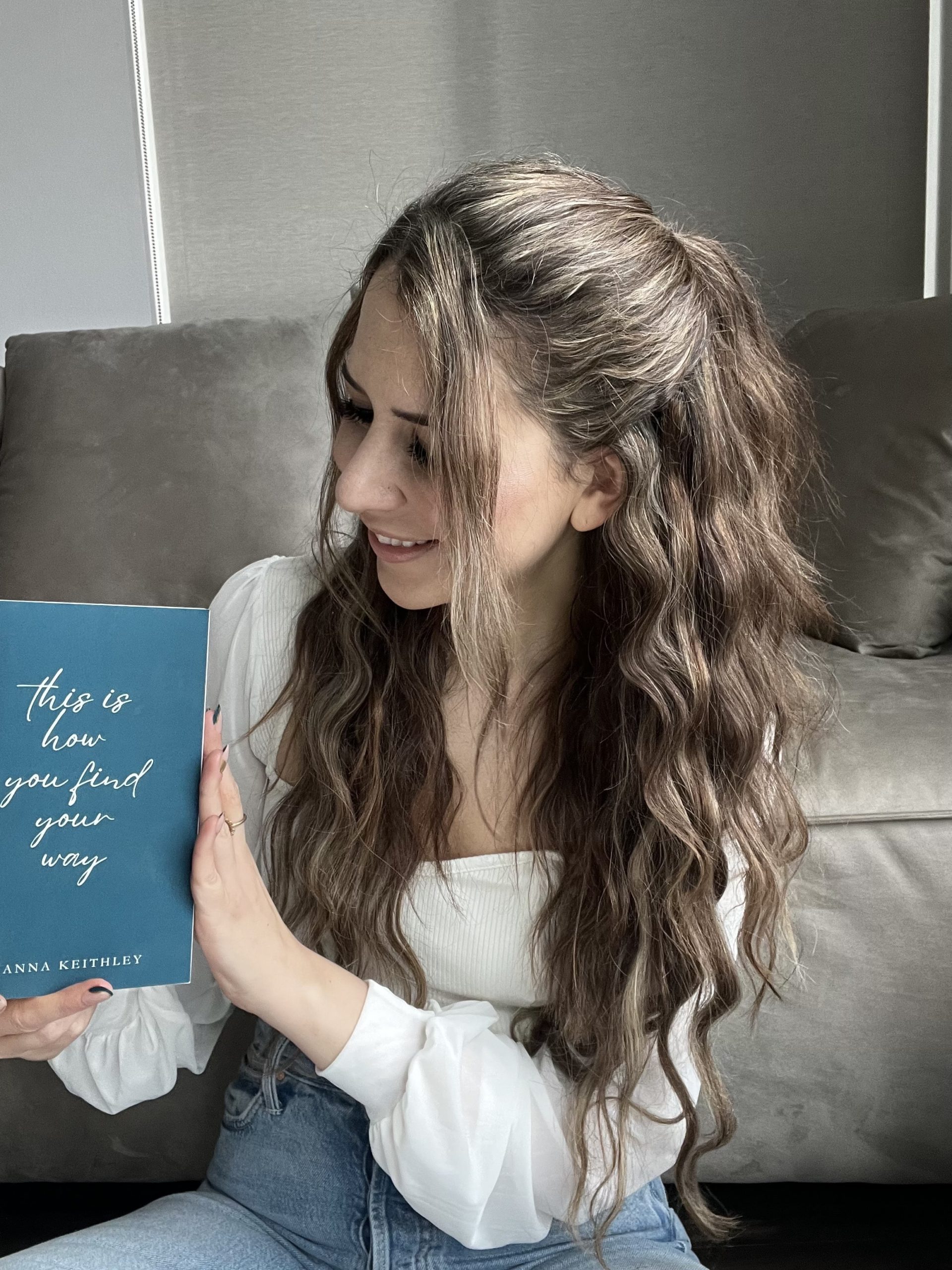
Zanna Keithley is an author, poet, and social media content creator who writes short prose dedicated to inspiring readers to follow their dreams, trust their intuition, and create beautiful and fulfilling lives. You can find her original writing on Instagram @zannakeithley.
